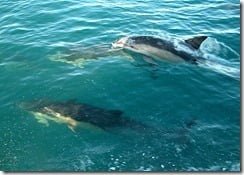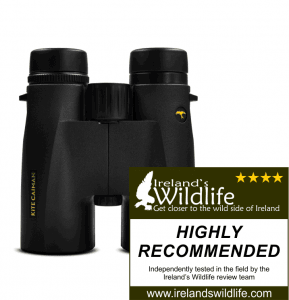 Pros: Solid entry-level binocular that’s comfortable and easy to use. Light, yet robust, this is an easy to handle binocular with good all-round ergonomics. Optically it delivers an impressively bright, sharp image across most of the wide field of view. Neutral colour balance, great contrast and minimal chromatic aberration.
Pros: Solid entry-level binocular that’s comfortable and easy to use. Light, yet robust, this is an easy to handle binocular with good all-round ergonomics. Optically it delivers an impressively bright, sharp image across most of the wide field of view. Neutral colour balance, great contrast and minimal chromatic aberration.
Cons: Slight “halo” effect on the periphery of the view evident in some lights. Lack of thumb indents on the chassis feels a little strange at first if it’s something you’re used to.
Price: RRP c. €285 (GB£249.99).
Value: Outstanding
Rating: Highly Recommended
Check out the Kite Caiman on the Kite Optics website.
The Kite Caiman is a solid new contender in the entry level 42mm binocular market. While there are a lot of binoculars to choose from in this price range, the Caiman combines excellent optics with great build quality and good ergonomics to deliver more than most at this price point. Optically it matches many binoculars costing significantly more and comes with an impressive 15-year warranty from Kite.
Buy the Kite Caiman 8×42 from CJ Wildlife/Birdfood.ie
Kite Caiman 8×42 Binocular, Full Review
 Kite binoculars always strike me as practical instruments: you get a real sense that every penny you spend on a pair of Kites is giving you a better binocular: better optics, better build, better usability for your money. There are no gimmicks… no “cutting edge” design statements that too often cater more for the marketing department than the end user… just an optical instrument that does the job its meant to do, and does it extremely well.
Kite binoculars always strike me as practical instruments: you get a real sense that every penny you spend on a pair of Kites is giving you a better binocular: better optics, better build, better usability for your money. There are no gimmicks… no “cutting edge” design statements that too often cater more for the marketing department than the end user… just an optical instrument that does the job its meant to do, and does it extremely well.
So when I was offered the opportunity to review the new entry level Caiman from Kite I was intrigued to see how they’d stack up.
Balance, handling and build quality
The first thing I noticed when I picked up the Caiman’s was how solid they feel. These may be Kite’s “entry level” in the full-size roof-prism binocular field, but there’s nothing entry level about the way these binoculars feel. The full aluminium chassis does its job well, lending these binoculars strength without going overboard on the weight (a quoted 699 g for the 8×42 model). The result is a binocular that’s reassuringly robust in the hand, but that feels light enough to carry and use all day.
The body is covered in a hard, but slightly yielding rubber armour, subtly textured, which lends a little grip. It makes the binoculars comfortable to hold, and will buffer the optics from the occasional inevitable knock when out in the field. One omission, which seems common across the Kite range, is the practically ubiquitous thumb indents on the underside. While the lack of these doesn’t affect the performance of the binocular in any material way, it does affect their ergonomics. The Caiman’s feel a little odd at first if you’re used to having the thumb indents.
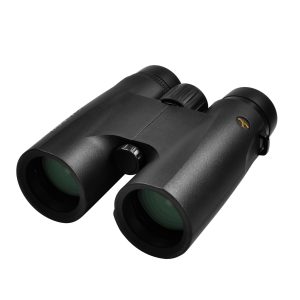 Perhaps unsurprisingly in an “entry level” binocular, there’s nothing groundbreaking in the design Kite has gone with here. The Caiman follows a traditional roof prism pattern of a single broad bridge between the two binocular barrels. It’s a comfortable, well tested design… but unlike the popular dual hinge or contemporary narrow single-hinge designs it doesn’t leave an extensive portion of the lower barrels exposed for that “wrap-around” grip. Like the lack of thumb indents this doesn’t really impact on the performance of the binocular, but it does take a bit of readjustment if you’re used to a pair with the wrap-around grip.
Perhaps unsurprisingly in an “entry level” binocular, there’s nothing groundbreaking in the design Kite has gone with here. The Caiman follows a traditional roof prism pattern of a single broad bridge between the two binocular barrels. It’s a comfortable, well tested design… but unlike the popular dual hinge or contemporary narrow single-hinge designs it doesn’t leave an extensive portion of the lower barrels exposed for that “wrap-around” grip. Like the lack of thumb indents this doesn’t really impact on the performance of the binocular, but it does take a bit of readjustment if you’re used to a pair with the wrap-around grip.
Once you get used to the foibles mentioned above the Caimans are very comfortable to carry and use in the field.
Focus
The focus mechanism on the Caimans is a joy to use. Smooth and fluid, the large central focusing wheel moves through 1.5 anticlockwise turns from a quoted close focus of 1.5 metres to infinity. In practice I found the close focus for the 8×42 I had nearer to the 1.8 metres documented for the 10×42… but still comfortably close enough for pretty much any subject you’re likely to want to look at through binoculars.
The dioptre adjustment is in the standard location just beneath the right eyepiece of the binocular. It turns easily with moderate resistance, and while it doesn’t lock in place, I never had a problem with it moving once set. There is no calibration scale on the dioptre adjustment, but it is possible to remember the set position (if you share your bins / somebody else adjusts them) by noting the position of the arrow on the barrel relative to the ridges on the adjustment ring.
Eye cups and eye relief
As with all kite models the Caiman’s come with rubber-coated metal (aluminium in this case) twist-up 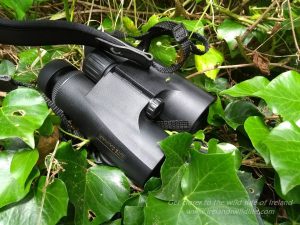 that are removable / replaceable. They simply screw off and screw back on again. It’s a feature seen in a few high-end binoculars… but I think it’s the first time I’ve ever seen it in a sub €300 pair.
that are removable / replaceable. They simply screw off and screw back on again. It’s a feature seen in a few high-end binoculars… but I think it’s the first time I’ve ever seen it in a sub €300 pair.
It’s an excellent feature… great for cleaning, and particularly good if an eye-cup gets damaged — which according to Kite is one of the main reasons binoculars get returned for repair. If an eye-cup on your Caimans gets a knock and is damaged the company will simply post out a replacement for you free of charge. No returns, no hassle, no fuss.
The eye-cups have three positions (fully up, fully down, with one intermediate stop) and the 8×42 model has a quoted eye relief of 17mm — which should mean they work well for most glasses wearers out there with the eye-cups twisted down.
Weatherproofing
No real surprises here. You’d expect even entry-level roof-prism binoculars to be sealed, and purged with inert gas (nitrogen, or in some cases argon), and the Caimans are no different in this regard. This makes them both waterproof and, crucially, prevents dust making its way inside the optical system. Purging the internal voids with nitrogen (or sometimes argon) drives out air, eliminating water vapour and preventing the possibility of internal fogging with extreme shifts in temperature (moving from a warm vehicle to scan a frozen lake shore in winter, for example).
Optical Performance
I’m always a little wary when I first look through a pair of what a manufacturer describes as their “entry level” binocular.
Birding and wildlife watching make perhaps the highest demands of optics. Detail, colour rendition and low-light performance are all critical factors, and to be perfectly frank most companies’ entry level offering simply isn’t up to the task. I tend to recommend that people look to the middle of a brand’s range of binoculars and upwards to get the minimal level of performance they’re going to need for productive and enjoyable wildlife observation.
So where does that leave the Kite Caiman?
While they may well be labeled as “entry level”, and are the lowest cost full-size roof-prism binocular Kite offers, the company simply doesn’t play in the lower echelon of the optics market. The Kite Caiman sit firmly in the lower half of what most people would class as mid-range binoculars, typically costing from around €250 up to about €400.
Image sharpness and field of view
 When I looked through the Caiman for the first time I was struck by how bright and clear the view was, and how wide. At 132m / 1000m (7.52°) the view feels expansive, almost inviting your eye to wander and look around the scene. While there are slightly wider fields of view on the market, what’s impressive here is how crisp and sharp the image stays right out towards the periphery of the field, with only moderate fall off right towards the edge.
When I looked through the Caiman for the first time I was struck by how bright and clear the view was, and how wide. At 132m / 1000m (7.52°) the view feels expansive, almost inviting your eye to wander and look around the scene. While there are slightly wider fields of view on the market, what’s impressive here is how crisp and sharp the image stays right out towards the periphery of the field, with only moderate fall off right towards the edge.
Colour fidelity, contrast and chromatic aberration
Colour fidelity is another important aspect of binocular design — particularly in optics being used primarily for wildlife observation and birding. Generally the better the quality of the glass, prisms and coatings used in a binocular’s optical system, the more evenly the light spectrum passes through the binocular barrels, rendering more natural, true-to-life colour to the scene being viewed.
For me Kite have got this spot-on with the Caiman — colours through the binoculars appear as they do with the naked eye. Contrast is also well balanced… enough to give the scene plenty of “pop”, and accurately portray subtle variations in hue, but not so much as to make the scene appear artificial.
The result is a pleasing, natural image that’s easy on the eye and is reminiscent of the view you get through much more expensive binoculars. I have to say I really enjoyed looking at things through the Caimans.
Inevitably when you’re producing an optical instrument at this price point (at any price point) there have to be compromises. Kite don’t specify the use of low dispersion HD / ED glass in the optical system for the Caimans, and if marketing doesn’t mention a buzzword in the blurb, it’s probably safe to assume it’s not there.
The primary contribution of ED glass is to control chromatic aberration — the colour fringing you can get when viewing high contrast subjects (dark birds against a bright overcast sky, for example, or light birds sitting on an expanse of dark water). While you can detect a degree of fringing when viewing extremely high contrast scenes, on balance the Caimans handle it very well — especially considering the lack of ED glass. It’s a testament to Kite’s optical pedigree (while relatively new to Ireland Kite has been supplying optics to the European market for decades), and the quality of the components and coatings used, that the Kite Caimans perform so well in this regard.
I never noticed chromatic aberration as a distraction during extensive normal use in the field across a wide range of conditions.
Low light performance and coatings
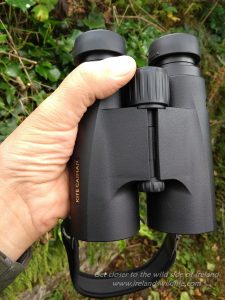 These Kite Caimans are fully multi-coated (FMC), and Kite uses its own suite of proprietary anti-reflective, high-transmission coatings on all internal and external glass surfaces. These coatings perform two main functions — they maximise the amount of light that passes through the binocular’s optical system and reaches your eye, and they prevent stray light and glare from bouncing around inside the optical system and detracting from the view.
These Kite Caimans are fully multi-coated (FMC), and Kite uses its own suite of proprietary anti-reflective, high-transmission coatings on all internal and external glass surfaces. These coatings perform two main functions — they maximise the amount of light that passes through the binocular’s optical system and reaches your eye, and they prevent stray light and glare from bouncing around inside the optical system and detracting from the view.
Whatever coatings Kite use here (they don’t give details), the Caimans certainly perform well, pulling in every scrap of available light and delivering a bright, clear image well into twilight and beyond. They also handle glare well, even looking into the light, which can be challenging for any binocular.
The only exception I noticed… and it only seems to happen occasionally… was a sort of “halo” affect around the periphery of the field of view in some viewing conditions. I’m not sure what caused it — reflections at the eyepiece end perhaps. It was occasionally distracting, but it didn’t happen often, and when it did I could easily eliminate it by shifting my eye position slightly.
Accessories
There isn’t a huge amount to say here. The Kite Caiman comes with the usual suite of accessories typical of mid-range optics: a decent quality padded neoprene neck strap, an eyepiece rain-guard that attaches to the strap, tethered objective lens covers, a padded fabric case, and a basic microfibre cleaning cloth. There’s also some cursory documentation on using and caring for your binoculars.
All of the accessories are functional, and as good as or better than anything you’re likely to find with binoculars in this price bracket.
Warranty
The Kite Caiman comes with Kite’s 15 year warranty — which for what they describe as an “Entry Level” binocular is very good indeed.
Conclusion
The Kite Caiman is a superb binocular for the money. While it doesn’t sport a cutting edge design or fancy bells and whistles, the quality of the optics is excellent. Kite has made some intelligent decisions here, and appears to have focused on exactly the right blend of features to deliver maximum optical performance in a functional, robust chassis at their desired price point.
It’s doubtful the Caiman will win any prizes for innovation — but if you’re looking for a solid all-purpose binocular with excellent optical performance at an affordable price it should definitely be on your shortlist. It would be a great choice for someone looking to step up to their first “serious” pair of birding and wildlife watching binoculars.
Buy the Kite Caiman 8×42 from CJ Wildlife/Birdfood.ie
Specification
From the Kite Optics website:
| 8X42 | 10X42 | |
|---|---|---|
| Magnification | 8 | 10 |
| Objective lens diameter (mm) | 42 | 42 |
| Exit pupil (mm) | 5.25 | 4.2 |
| Min. focus (m) | 1.5 | 1.8 |
| Field of view (m/1000m) | 132 | 105 |
| eye relief (mm) | 17 | 15 |
| interpupillary distance(mm) | 74-57 | 74-57 |
| Height (mm) | 146 | 146 |
| Max width (mm) | 128 | 128 |
| Min width (mm) | 110 | 110 |
| Weight (g) | 699 | 690 |
| Twilight factor | 18.3 | 20.5 |
| waterproof | yes | yes |
| gas filled | yes | yes |
| warranty (years) | 15 | 15 |
Acknowledgement
I’d like to thank Kite Optics for submitting the Caiman 8×42 for review on Ireland’s Wildlife.
NB. Ireland’s Wildlife has no specific affiliation to any optics or gear manufacturer. All reviews on the site are completely independent and objective and carried out in accordance with our terms and conditions. If you’re an optics or gear manufacturer and would like to submit your product for review on the site please drop us a line using the contact form and we can take things from there.




